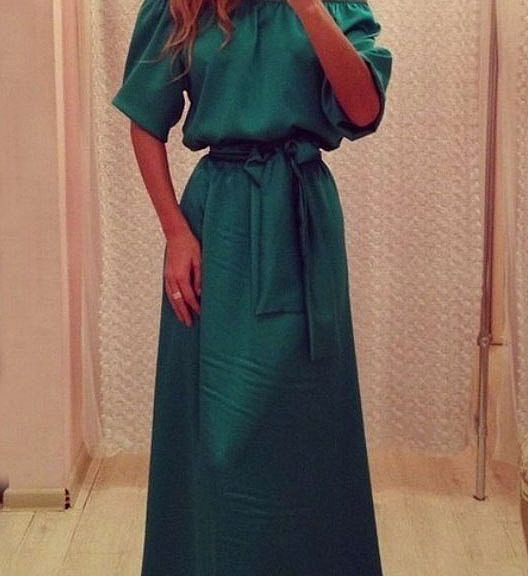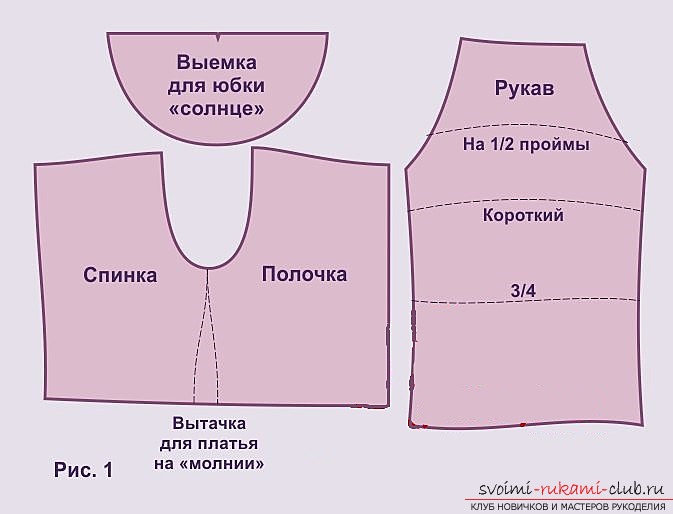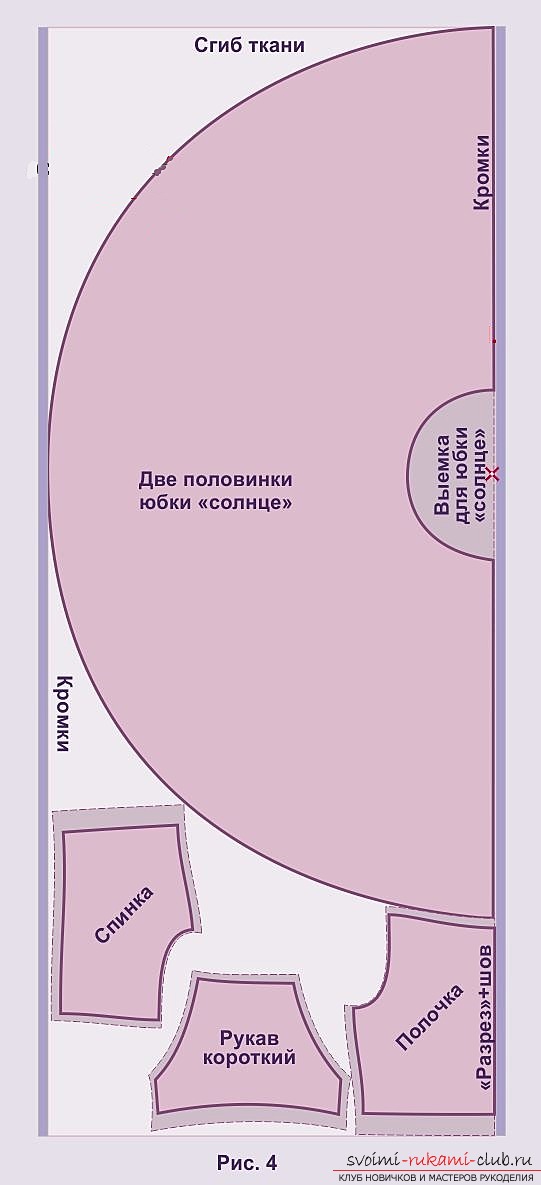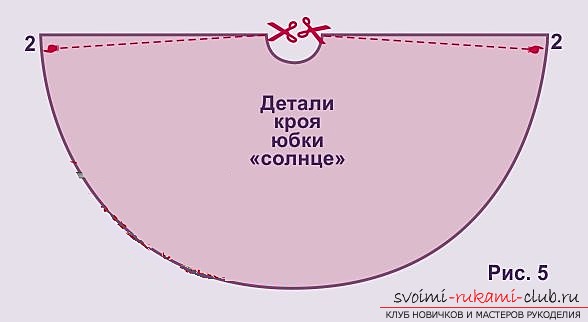
We make new clothes in our summer wardrobe with our own hands. Modern patterns of peasant dresses without difficulty. Instructions and photos
Your attention is a patternpeasant dresses. This is a very beautiful and elegant outfit, which can skillfully emphasize all the dignity of any woman. The most important thing is to sew it yourself. In order to independently produce a dress does not need to be an experienced specialist, even a beginner will quickly cope with such work. For the dressing of this dress, you need to go through three stages: the production of the bodice, sleeves, as well as the notch of the notch for cutting the skirt-sun of our outfit. You will need two to six meters of fabric, depending on the style of your skirt, as well as the length of the dress and sleeves. Below are the formulas that are needed to calculate the amount of material. So before buying a fabric, it's best to carefully calculate everything so that everything is right. The main feature of this dress is that it is suitable for almost any woman or girl, regardless of the figure or age. To make the outfit, it is best to choose a swimming cloth, for example a thin floating wool and flax. You can also use a thin jacquard. For our model is perfect cotton, poplin, as well as any kind of chiffon or dense silk. If you want to make your dress even more chic, then safely choose for tailoring a cambric white or gray linen, embroidered with hand embroidery. Also, masters often choose knitted fabrics, both dense and thin, which have a small coefficient of extensibility. You can experiment with thin cotton fabrics with stuffed cages.  Before starting the pattern, it is very important to do everythingnecessary measures. To begin with, we will define the dress size. To do this, divide into two girths of your chest. In other words, your size is half the girth of your chest, denoted as Cr. It is useful when using a pattern to use tables of standard measures for women, men and children. Of course, every woman has her own individual parameters, so be careful while taking measurements. But it is useful to use the table of reference measures. Before cutting, check the correspondence between your personal measurements and the values from the table. To do this, you need to measure your figure, record all the results in a table, and then check and compare with the tabulated values. Most of the values will certainly coincide, only a few, due to various increases in stitching and fitting, will be different. It is useful to know that the sizes of trousers and skirts also get their numbering depending on your gender of the chest girth. Let's turn to the cutting of our stylish peasant dress. In order to make the correct pattern of attire, you must carefully follow the instructions given. Before you start making patterns, you need to decide how long your sleeves will be, and what style you choose for the skirt - the sun or the tatanka. If you want to make a sun skirt, then you also need a notch pattern. In such cases, it is best to make the back and shelves separately, cutting out the dart. Thanks to this, your dress will not be very large around the waist, and if you want, you can sew a braid-zipper to the side seam. Consider the scheme of cutting our skirt-tatyanka, as this is a simpler option. In the figure below you can see the most common mistake often made by beginning cutters. Nevertheless, it is useful for us in order to accurately calculate the amount of necessary tissue. The consumption for the presented style of our dress with a tatyanka skirt will be as follows: (length of the skirt and two additional centimeters for processing) + (length of the bodice and six additional centimeters for processing) + (length of sleeves with additional centimeters for processing). It is very important to consider the significant allowances to the bottom of the bodice as well as the sleeves when counting the flow.
Before starting the pattern, it is very important to do everythingnecessary measures. To begin with, we will define the dress size. To do this, divide into two girths of your chest. In other words, your size is half the girth of your chest, denoted as Cr. It is useful when using a pattern to use tables of standard measures for women, men and children. Of course, every woman has her own individual parameters, so be careful while taking measurements. But it is useful to use the table of reference measures. Before cutting, check the correspondence between your personal measurements and the values from the table. To do this, you need to measure your figure, record all the results in a table, and then check and compare with the tabulated values. Most of the values will certainly coincide, only a few, due to various increases in stitching and fitting, will be different. It is useful to know that the sizes of trousers and skirts also get their numbering depending on your gender of the chest girth. Let's turn to the cutting of our stylish peasant dress. In order to make the correct pattern of attire, you must carefully follow the instructions given. Before you start making patterns, you need to decide how long your sleeves will be, and what style you choose for the skirt - the sun or the tatanka. If you want to make a sun skirt, then you also need a notch pattern. In such cases, it is best to make the back and shelves separately, cutting out the dart. Thanks to this, your dress will not be very large around the waist, and if you want, you can sew a braid-zipper to the side seam. Consider the scheme of cutting our skirt-tatyanka, as this is a simpler option. In the figure below you can see the most common mistake often made by beginning cutters. Nevertheless, it is useful for us in order to accurately calculate the amount of necessary tissue. The consumption for the presented style of our dress with a tatyanka skirt will be as follows: (length of the skirt and two additional centimeters for processing) + (length of the bodice and six additional centimeters for processing) + (length of sleeves with additional centimeters for processing). It is very important to consider the significant allowances to the bottom of the bodice as well as the sleeves when counting the flow.  Why do we need to make allowances for the bodice? So that after you put on the bodice and tie it up with a belt, you can accurately determine the size of the necessary fill. At the bottom of the sleeves, allowances are required for a large fold. Then the underside of the fabric will not look out from under the dress. All other allowances can be made in one centimeter, except the armhole. It must be cut without a single allowance, because any allowance will make its length less than necessary. Below is the correct drawing for cutting a dress with a tatyanka skirt. The fabric should be folded in half to combine the edges. Cut the rectangle, from which we will make our "Tatyanka". Again, we fold the material twice as wide as the "shelf-back" detail. The pattern should be placed half-bent on the fabric bend. Taking into account the necessary allowances, we carefully cut out the material.
Why do we need to make allowances for the bodice? So that after you put on the bodice and tie it up with a belt, you can accurately determine the size of the necessary fill. At the bottom of the sleeves, allowances are required for a large fold. Then the underside of the fabric will not look out from under the dress. All other allowances can be made in one centimeter, except the armhole. It must be cut without a single allowance, because any allowance will make its length less than necessary. Below is the correct drawing for cutting a dress with a tatyanka skirt. The fabric should be folded in half to combine the edges. Cut the rectangle, from which we will make our "Tatyanka". Again, we fold the material twice as wide as the "shelf-back" detail. The pattern should be placed half-bent on the fabric bend. Taking into account the necessary allowances, we carefully cut out the material.  We proceed to the next stage. To properly cut the sleeves, fold the rest of the fabric along the width of the sleeve. If you have a small size, then you can put the sleeve near the bodice. In this case, the cutting of the peasant dress will take place in two stages. The cutting of our dress with a skirt-sun is a little more complicated, but if everything is done correctly - you will not have any difficulties. Fold our fabric in half, face sides inside. The edges must be aligned. It is important that the fold goes along the transverse section. From the bend along the edge, measure the length of our skirt. Attach a notch for the skirt-sun, and then measure the length one more time. Press down the groove pattern with a loader or pin it with pins, and then gently circle.
We proceed to the next stage. To properly cut the sleeves, fold the rest of the fabric along the width of the sleeve. If you have a small size, then you can put the sleeve near the bodice. In this case, the cutting of the peasant dress will take place in two stages. The cutting of our dress with a skirt-sun is a little more complicated, but if everything is done correctly - you will not have any difficulties. Fold our fabric in half, face sides inside. The edges must be aligned. It is important that the fold goes along the transverse section. From the bend along the edge, measure the length of our skirt. Attach a notch for the skirt-sun, and then measure the length one more time. Press down the groove pattern with a loader or pin it with pins, and then gently circle.  From the contour line, measure the length of the skirt several timesand in different directions. Then draw a smooth line for the bottom. All other parts are placed on the fabric so as to save as much as possible. Always make sure that the seam allowances are counted. When you open a skirt-sun, do not forget to remove all share slices. To calculate the consumption of our material, we need to use the presented formula: (two lengths of the skirt + notch, as well as a hem and a three centimeter base) + (the length of the bodice and an additional six centimeters) and everything is multiplied by two. Sewing this dress is very simple, you will not have any difficulties. First you need to gently stitch all the details of the bodice and sleeves. The kuliska should be made along the upper cut. You can also process the bottom of the sleeves if you are completely confident. After that, you need to try on the bodice to check and understand the need for additional straps on the upper cut, or you will have enough kulisok with an elastic band. Also determine which amount of admission will look best for your figure. To do this, you just need to tie a small thin belt around your waist. When you accurately determine the amount of overlap, excess allowances can be safely cut off. One half of the skirt-sun connect with the shelf, and the second - with the back.
From the contour line, measure the length of the skirt several timesand in different directions. Then draw a smooth line for the bottom. All other parts are placed on the fabric so as to save as much as possible. Always make sure that the seam allowances are counted. When you open a skirt-sun, do not forget to remove all share slices. To calculate the consumption of our material, we need to use the presented formula: (two lengths of the skirt + notch, as well as a hem and a three centimeter base) + (the length of the bodice and an additional six centimeters) and everything is multiplied by two. Sewing this dress is very simple, you will not have any difficulties. First you need to gently stitch all the details of the bodice and sleeves. The kuliska should be made along the upper cut. You can also process the bottom of the sleeves if you are completely confident. After that, you need to try on the bodice to check and understand the need for additional straps on the upper cut, or you will have enough kulisok with an elastic band. Also determine which amount of admission will look best for your figure. To do this, you just need to tie a small thin belt around your waist. When you accurately determine the amount of overlap, excess allowances can be safely cut off. One half of the skirt-sun connect with the shelf, and the second - with the back.  Swipe a few lines with a rubber threadfrom the waist. Working with such a rubber band is very easy and convenient. Carefully work on each stitch, and then prune the zipper. Lightning can be stitched, as in any other dress.
Swipe a few lines with a rubber threadfrom the waist. Working with such a rubber band is very easy and convenient. Carefully work on each stitch, and then prune the zipper. Lightning can be stitched, as in any other dress.  That's all. The pattern of the peasant dress is complete and you now have a very stylish and beautiful outfit in which you will be adorable.
That's all. The pattern of the peasant dress is complete and you now have a very stylish and beautiful outfit in which you will be adorable.




